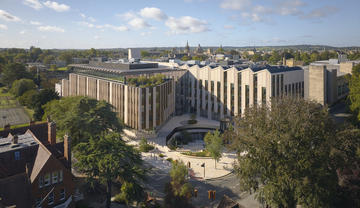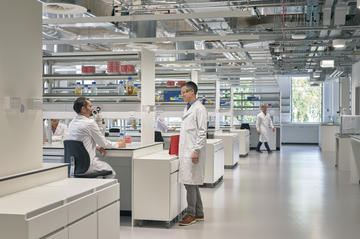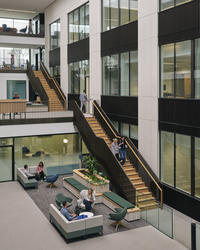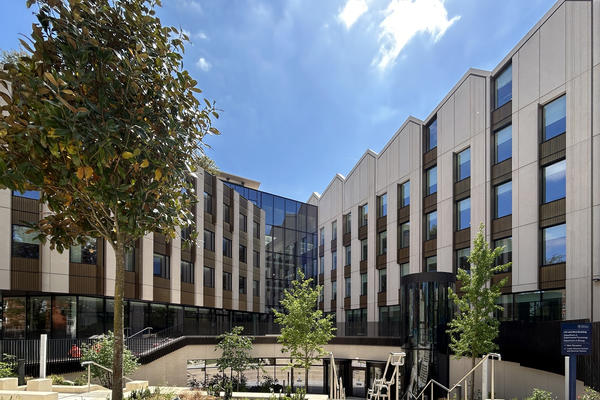The Life and Mind Building: a new home for discovery and collaboration
A landmark moment for Oxford science — the Life and Mind Building (LaMB) has officially opened, bringing together researchers, students, and visitors in a space designed to transform the study of both life and mind.
A World-Class Facility at the Heart of Oxford

(c) NBBJ/Ty Cole
The £200 million Life and Mind Building is one of the largest construction projects in the University’s history. Enabled by Legal & General (L&G) and designed by international architects NBBJ, the affectionately named LaMB now houses the Departments of Biology and Experimental Psychology, alongside the Ineos Oxford Institute for antimicrobial research (IOI).
Offering more than 269,000 square feet of teaching, research, and public engagement space, the building provides a home for over 1,400 scientists, academics, and support staff, and welcomes around 1,000 undergraduate students each year. It brings together two of Oxford’s most dynamic disciplines to explore the big questions of our time — from biodiversity loss and climate change to mental health and cognition. Professor Irene Tracey, Vice-Chancellor of Oxford University says of the milestone
“The opening of this inspiring building is a proud moment in our partnership with Legal & General, and a wonderful milestone for Oxford, by uniting biologists and experimental psychologists under one roof, the Life and Mind Building will spark fresh ideas, foster collaboration, and help us tackle some of the biggest challenges facing our world.”
Designed for Connection
From its earliest design stages, the LaMB was envisioned as more than a building — it is a space created to connect people and ideas. Light-filled atria, open meeting spaces, and shared cafés encourage informal interaction and cross-disciplinary collaboration. Students and researchers now have cutting edge facilities all in one building, these spaces make the LaMB one of the most advanced environments for studying both biological and psychological sciences in the world. On the lower levels, teaching and study areas sit alongside exhibits and a welcoming café — creating a hub where the University community and visitors can meet, learn, and exchange ideas.
A New Era for Biology
For the Department of Biology, the move to the LaMB represents a new chapter. The department explores the diversity of life on Earth at every scale — from molecules to ecosystems — and focuses its research through five interconnected hubs:

(c) NBBJ/Ty Cole
- Building resilient ecosystems for a changing world
- Driving bioinnovation and sustainable futures
- Conserving biodiversity for people and planet
- Tackling infectious disease and enhancing global health
- Bridging natural and artificial intelligence
Being together in one building for the first time, Biology’s researchers and students have a home that fosters discovery and collaboration across molecular, animal and plant biology. Our planet is facing unprecedented challenges – but our world-leading science, combined with these new facilities, puts us on the path to solving them. Professor Martin Maiden, Head of Department of Biology says
“With specialised laboratories and world-class shared spaces, the LaMB provides Biology with the environment necessary to thrive in the 21st century, it will inspire innovation, support our research community, and strengthen partnerships within and beyond Oxford — a building that will truly have global impact.”
Linking Life and Mind

(c) NBBJ/Ty Cole
At its heart, the Life and Mind Building embodies the University’s ambition to bridge the life and mind sciences — connecting research on the natural world with the study of brain, behaviour, and cognition.
Collaboration between biologists and psychologists is already exploring the intersection of natural and artificial intelligence — studying how living systems learn, adapt, and make decisions, and how these insights can inspire the next generation of AI systems that are more adaptive, robust, and context-aware.
This dynamic exchange reflects the LaMB’s core purpose: to unite disciplines, share knowledge, and shape solutions to the defining challenges of our age. The LaMB’s physical bridges don’t just connect its wings — they symbolise something bigger: the connections between disciplines, ideas, and people that will define the future of science at Oxford and beyond.
Dr Charly Treiber, who leads a research group studying how genomic variation shapes behaviour, reflected:
“From the moment we first stepped into the LaMB’s atrium, it felt like the beginning of a new chapter – not just a new space, but a new way of doing research. The light-filled open spaces invite exchange and collaboration. As a biologist studying individuality in animals, the chance to bump into colleagues from psychology – sometimes literally at the coffee station – is both refreshing and inspiring.”
Professor Laurence Hunt, department of Experimental Psychology whose work explores the neural basis of decision-making, shared a similar sentiment:
“Our discipline has long engaged with brain, behaviour and cognition – and we have so much to gain from direct contact with biology. The LaMB promises not just a building, but a hub where new research directions can grow in unanticipated ways.”
https://www.youtube.com/embed/_amVvwR3XHM?si=d4Qw2IxCsMnTByQ-


